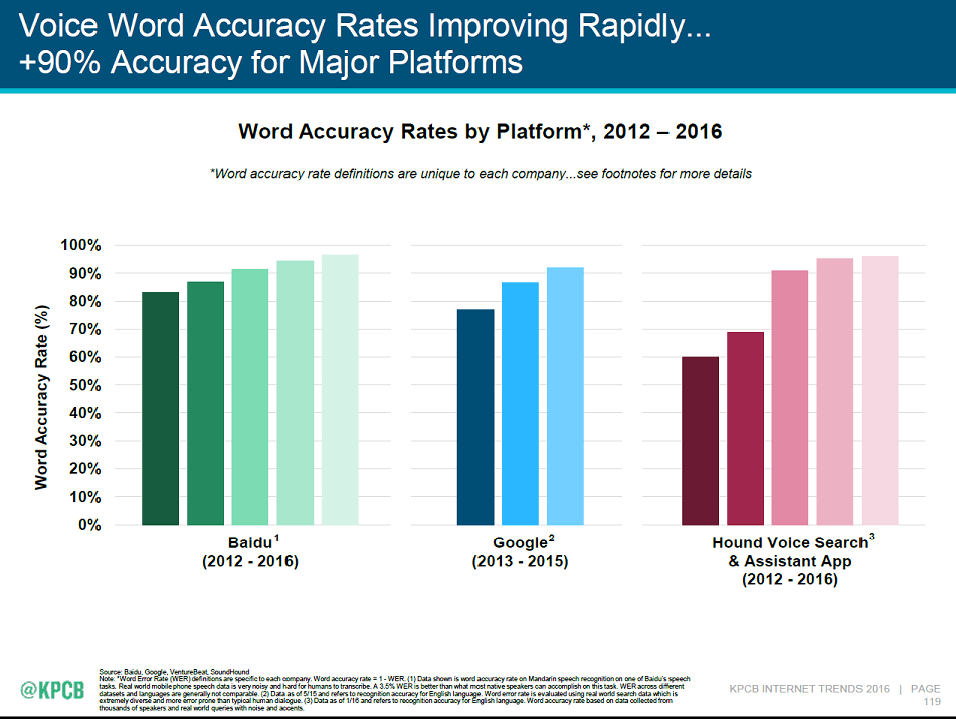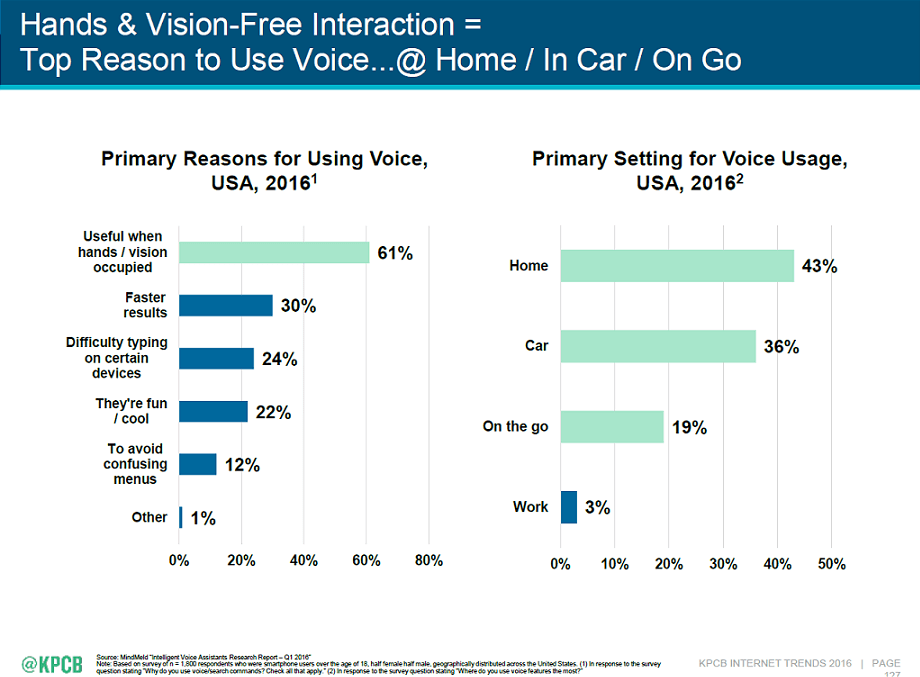The voice search explosion and how it will change local search
Voice search usage is seeing unprecedented growth, with personal assistant devices leading the way. Columnist Wesley Young explores why this new medium is taking off, how it differs from keyword searches, and the challenges for local businesses to compete on yet another platform.
Since I noted Timothy Tuttle of Mindmeld’s LSA16 comments about the sudden increase in the volume of voice search queries, I’ve noticed an increasing number of articles on the subject. If the attention being given voice search is an indication of its anticipated impact on the marketplace, then it’s going to be a big deal.
The potential for voice search to become a major search medium is well illustrated by the number of slides Mary Meeker devotes to the topic in her annual Internet Trends report that was just released this month. Out of 213 slides, Mary included 23 slides on voice search. And while the numbers on voice search growth vary quite widely, they all agree on one trend: explosive growth.
Explosive growth and the reason behind it
At LSA 16, Tuttle shared that within one year (last year), the use of voice search went from a statistical zero to 10 percent of all search volume. That was huge. Yet more recent numbers show that growth accelerating — Google announced at I/O that 20 percent of all searches have voice intent, while Meeker’s charts show that in May 2016, 25 percent of searches on Windows 10 taskbar are voice searches.
Many explain the reason for voice technology’s growth is the improved rate at which voice commands are accurately captured. My personal experience with Siri a couple of years back was not a good one.
I started watching one of Matt Damon’s Jason Bourne movies but couldn’t figure out where in the series it fell. So I asked Siri, “What order are the Bourne movies in?” Her reply: “You want to order a porn movie? Here are the 10 closest adult movie stores near you . . .” Fortunately, my wife heard my original query. But it illustrates the point — sometimes close isn’t good enough.
In 2013, Google’s platform had a word recognition accuracy rate of below 80 percent, according to Meeker’s figures. Just a couple of years later, that rate rose above 90 percent. Baidu now exceeds a 95-percent accuracy rate. Yet Andrew Ng, chief scientist at Baidu, stated that there is still significant improvement to make — that 99-percent accuracy is a game-changer. He believes 99 percent will make the difference between people barely using it and people using it all the time. At the current pace of improvement, we will get there soon.
A new player in search: Amazon
Perhaps the biggest beneficiary of the recent boom in voice-controlled personal assistants and search is Amazon. Whether it was planned or happened by pure luck, Amazon seems to have timed the release of Amazon Echo perfectly.
As Apple suffers due to the market saturation of smartphones and voice technology improvements are creating a new and satisfying user experience, the Echo’s voice-only interface distinguishes it from the vast sea of screen-based devices that have dominated the market.
It is estimated that in 2016, Apple will see a decline in sales of iPhones for the first time in a decade, while Amazon’s Echo sales are on the rise. Unit sales are still only a fraction of the sales of iPhones, but growth is impressive. In the first quarter of 2016, Amazon shipped about one million Echos, compared to Apple’s estimated 50 million iPhones, according to charts by Meeker.
However, that Amazon number reflects a year-over-year growth rate of about 150 percent. Amazon has over 300 million users. If the Echo gets adoption rates similar to the Kindle (both Fire and Reader), that could translate into total sales of approximately 168 million units. That’s not an unreasonable projection, given reports that the Echo is now outselling the Kindle.
How voice search is being used
And the ability to use voice recognition seems to uniquely satisfy a number of valuable consumer needs that would support continued use and growth of the medium.
Meeker cites a study that 61 percent of users state the primary reason they use voice is the utility of it when their hands or vision are occupied. What comes to mind immediately is use while driving. And yet, while a substantial number, 36 percent, said they primarily use voice commands in the car, 43 percent stated their primary use was at home.
Hound, a voice query app, found a fairly even split of voice query into four categories — Personal Assistant (27 percent), Fun and Entertainment (21 percent), General Information (30 percent) and Local Information (22 percent). Some of the functions performed in each category likely include the following examples:
- Personal Assistant — Shopping lists; calendar events; appointment reminders; to do lists; making phone calls; online bookings; dictating and sending texts.
- Fun and Entertainment — Listening to and buying music; interactive games and social media; searching and accessing video; sports schedules; TV listings.
- General Information — Web search; recipes; news; banking and finance; travel.
- Local Information – Restaurants; shopping; directions; home services; pizza; weather; reviews; local events; traffic.

Source: KPCB 2016 Internet Trends
Marketers will need to employ new strategies for local voice search
Given the growth of voice search, it has great potential to affect how local businesses are found. While it won’t likely replace existing screen-based search, voice search will soon be enough of a factor that businesses need to understand strategies for being found by voice search.
And a significant portion of those strategies will be new: No one really has an existing SEO strategy for Amazon, so that will need to be understood and developed. Right now, Amazon’s Echo relies on “skills” — the equivalent of apps — to provide data which the Echo references for responses. For example, the Echo utilizes Yelp’s database for local service providers, retail and restaurants, as well as reviews in ranking and formulating its responses. As more skills are incorporated into Echo, it will become more and more complex for a business to optimize its profile and standing among all the various sources of information.
The number of skills in Amazon is small, but again, growth is impressive. At the beginning of the year, there were only 130 skills. Today, that number is over 1,000. Amazon doesn’t yet categorize or prioritize skills like other app stores, making them difficult to discover.
The Echo defaults to Bing for any general search query that is not covered by a skill, but that search experience is also relatively poor in its current form. It will be interesting to see if Amazon partners with Bing to improve general search. I assume it would be Bing, because it’s unlikely to be Google.
Voice search is different from keywords in a search box
Google isn’t likely to partner because it is developing a home-based personal assistant of its own, aptly named Google Home. Google clearly has an advantage in its unmatched aptitude and dominance in search. Yet even with its huge index that powers the best search query response on the planet, voice search will create new wrinkles in the process that may level the playing field to some degree.
The way individuals interact through voice search and queries is different from the way they interact with a search box. Because search queries are more conversational in natural language, they tend to be longer, more nuanced and reveal greater intent. For example, a user might type in keywords “a/c repair near me” but might tell a voice assistant, “There’s a burning smell coming from my outside Trane a/c condenser unit.”
It’s also easy to see how queries may no longer be “search-oriented” in the way we define it today but rather jump over search straight into a request for action. For example, instead of searching for pizza restaurants near me, you can now request Alexa (Echo) to order you a Large Deep Dish Pepperoni Pizza with mushrooms and extra sauce and have it delivered to your house via the Domino’s Pizza skill.
Likewise, the natural progression for local search for service providers would be appointment-based. Instead of searching for electricians near me, the request might be a request for an appointment with the highest-rated local electrician who is available between noon and 2:00 p.m. tomorrow.
Both of these scenarios bypass traditional search and the opportunity for competitors to try and attract your attention through paid search ads, high ranking organic listings, or even adjacent listings in general browsing activity.
Amazon Echo’s focus on skills for access to content also will put small businesses at a competitive disadvantage compared to brands and franchises that have the scale to invest in developing content for the platform. Brands that have done so include Capital One, Uber, Domino’s, TechCrunch and NBC.
I’ve previously written about how it usually does not make sense for a local business to develop an app, and the same logic applies to Echo skills. However, my suggestion that local businesses optimize their presence on vertical sites that have apps is also a solution here.
For example, Kayak is integrated with the Echo, and users can find flight information, search for hotels and get price quotes for the travel industry. A local bed and breakfast is likely to see much more return by making sure its information on Kayak is comprehensive, accurate and optimized to be referenced within Kayak than by trying to build a skill on its own that would likely never be found or accessed by users of Echo.
Another example of voice search issues to be determined: What will be the SERP equivalent? How deep or how many providers will be mentioned or listed? Another issue: how do you make sure the personal assistant pronounces your name properly? Names can be tricky, and pronunciations that don’t match spellings can lead to your business not being recognized by the user or misidentified.
Future developments
Undoubtedly, other issues unique to voice will crop up, and it’s hard to anticipate what strategies might work best until voice search matures further and we see more data behind how people will utilize the technology. Others are also working on their versions of the technology with Facebook developing a personal assistant called “M” and Apple working on a standalone device for Siri, making it available to third-party developers and adding it to the Mac desktop experience in its next OS update.
However, there’s a chicken-and-egg problem: Just as the platforms are still working on making their service complete, consumers are still figuring out how to ask for what they want. Their queries will change as the services broaden and improve their offerings.
What we do know is that voice search will not mimic the search box. As more and more consumers turn to voice search, marketers will need to figure out how voice search queries and results differ from search engine results and help local businesses navigate the way through being found in results to being found in voice search.
Contributing authors are invited to create content for Search Engine Land and are chosen for their expertise and contribution to the search community. Our contributors work under the oversight of the editorial staff and contributions are checked for quality and relevance to our readers. The opinions they express are their own.
Related stories
New on Search Engine Land


